Nordic countries
| Nordic countries | ||
|---|---|---|
 |
||
| Capitals | Copenhagen; Stockholm; Oslo; Helsinki; Mariehamn; Tórshavn; Reykjavík; Nuuk | |
| Official languages | Danish; Faroese; Finnish; Greenlandic; Icelandic; Norwegian; Swedish | |
| Membership | ||
| Area | ||
| - | Total | 3,501,721 km2 1,352,022 sq mi |
| Population | ||
| - | 2009 estimate | 25,382,411 |
| - | 2000 census | 24,116,478 |
| - | Density | 7.24/km2 18.8/sq mi |
| GDP (PPP) | 2008 estimate | |
| - | Total | $1011.705 billion |
| GDP (nominal) | 2008 estimate | |
| - | Total | $1559.736 billion |
| Currency | Euro; Swedish krona; Danish krone; Norwegian krone; Icelandic króna | |
The Nordic countries make up a region in Northern Europe and the North Atlantic which consists of Denmark, Finland, Iceland, Norway and Sweden (all of which use a Nordic Cross flag) and their associated territories which include the Faroe Islands, Greenland, Svalbard and Åland. Scandinavia is sometimes used as a synonym for the Nordic countries,[1] although within the Nordic countries the terms are considered distinct.
The region's five nation-states and three autonomous regions share much common history as well as common traits in their respective societies, such as political systems and the Nordic model. Politically, Nordic countries do not form a separate entity, but they co-operate in the Nordic Council. The Nordic countries have a combined population of approximately 25 million spread over a land area of 3.5 million km² (Greenland accounts for around 60% of the total area).
Although the area is linguistically heterogeneous, with three unrelated language groups, the common linguistic heritage is one of the factors making up the Nordic identity; the continental North Germanic languages – Danish, Norwegian and Swedish – share a degree of mutual intelligibility with each other and one of those languages is (with some exceptions) learnt in school by those not speaking any of them natively. Besides these and the insular Scandinavian languages Faroese and Icelandic, all belonging to the Indo-European languages, there are the Baltic-Finnic and Sami branches of Uralic languages, spoken in Finland respectively northern Norway, Sweden and Finland and Greenlandic, an Eskimo-Aleut language, spoken in Greenland.
Etymology and terminology
The term 'Nordic countries' is derived from the French term Pays nordiques as an equivalent of the local terms Norden (Scandinavian languages), Pohjola / Pohjoismaat (Finnish language), Põhjala / Põhjamaad (Estonian language), Norðurlönd (Icelandic), Norðurlond (Faroese) and Davveriikkat (North Sámi) with the meaning of "The North(ern lands)".
In English usage, the term Scandinavia is sometimes used—though not consistently—as a synonym for the Nordic countries. From the 1850s, Scandinavia was considered to include politically and culturally, Denmark, Norway, and Sweden. Geographically, the Scandinavian Peninsula includes mainland Sweden and mainland Norway, and also a part of Finland, while the Jutland Peninsula includes mainland Denmark and a small part of Germany. Denmark proper has not included any territory on the Scandinavian Peninsula since 1658. The Faroe Islands and Iceland are "Scandinavian" in the sense that they were settled by Scandinavians and speak Scandinavian languages, but geographically they are not part of Scandinavia. Having once been a part of Sweden, Finland has been significantly influenced by Swedish culture and part of it is geographically within Scandinavia, whereas the Finnish language is not related to the Scandinavian languages. Greenland was settled by the Norse, and is currently part of the Danish realm, with the Danish language spoken by nearly all inhabitants, while geographically it is part of North America.
In geology, the term for the land area which lies above sea level on the Baltic shield (also known as the Fennoscandian Shield) is Fennoscandia (from the Latin toponyms Fennia and Scania).
Merriam-Webster Online Dictionary defines "Nordic" as an adjective dated to 1898 with the meaning "of or relating to the Germanic peoples of northern Europe and especially of Scandinavia" or "of or relating to a group or physical type of the Caucasian race characterized by tall stature, long head, light skin and hair, and blue eyes".[2] Before the 19th century and romantic nationalism, the term Nordic may have been used more as a synonym for Northern to mean Northern Europe including the Baltic countries (at that time Lithuania, Livonia and Courland) and occasionally the British Isles and other lands on the shores of the Baltic and North Seas.
While the term Scandinavia is commonly used for Denmark, Norway and Sweden, the term the Nordic countries is used unambiguously for Denmark, Norway, Sweden, Finland, and Iceland, including their associated territories (Greenland, the Faroe Islands, and the Åland Islands).[3] Scandinavia can thus be considered a subset of the Nordic countries.
In addition to the mainland Scandinavian countries of
 Denmark (Constitutional monarchy with a Parliamentary system -- an autonomous constituent country within the Danish Realm)
Denmark (Constitutional monarchy with a Parliamentary system -- an autonomous constituent country within the Danish Realm) Norway (Constitutional monarchy with a Parliamentary system, independent since 1905)
Norway (Constitutional monarchy with a Parliamentary system, independent since 1905)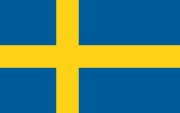 Sweden (Constitutional monarchy with a Parliamentary system, de facto independent kingdom since 1523)
Sweden (Constitutional monarchy with a Parliamentary system, de facto independent kingdom since 1523)
the Nordic countries consist of
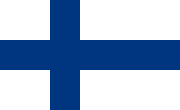 Finland (Semi-presidential republic, independent since 1917)
Finland (Semi-presidential republic, independent since 1917)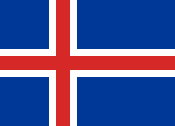 Iceland (Parliamentary republic, independent since 1918, although in a union with and a dependency of Denmark until 1944)
Iceland (Parliamentary republic, independent since 1918, although in a union with and a dependency of Denmark until 1944)
and
 Faroe Islands (an autonomous constituent country within the Danish realm, self-governed since 1948)
Faroe Islands (an autonomous constituent country within the Danish realm, self-governed since 1948) Greenland (an autonomous constituent country within the Danish realm, self-governed since 1979)
Greenland (an autonomous constituent country within the Danish realm, self-governed since 1979) Åland Islands (an autonomous province of Finland since 1920)
Åland Islands (an autonomous province of Finland since 1920)
Estonia has applied for membership in the Nordic Council , referring to its cultural heritage and close linguistic links to Finland, although normally Estonia is regarded as one of the Baltic countries. All Baltic states have shared historical events with the Nordic countries, including Scandinavia, during the centuries.
History

The Nordic countries are characterised by similar structures of their societies and cultural traits. This results not only from similar environmental realities and thus traditional livelihoods but also from a shared history.
The indigenous population of northern half of continental "Norden" are the Sami people, whereas the southern half is the historical "urheimat" of the Norse cultures and the forefathers of the Finnish. The western isles may be said to have been first settled by the Norse, with two caveats: Inuit arrived on northwestern Greenland more or less at the same time as the Norse came to the island's southeast; and in the settlement of Iceland, Celts were also active.
During the Dark Ages, what are now Norway, Sweden, Denmark and from 10th century onwards also Iceland shared a similar cultural, linguistic (Old Norse) and religious (Norse mythology) environment. From ca. the 12th century onwards what is now Finland (linguistically Baltic-Finnic and broader Finno-Ugric) started sharing the common developments as it was increasingly integrated into the kingdom of Sweden. As another example of a deeply rooted unifying past could be taken the indigenous Sami lifestyle (linguistically Finno-Ugric) across what is now northern Norway, Sweden and Finland (and beyond). Indeed, all Nordic countries have minority groups deriving or claiming heritage of a population residing within another Nordic state.
After being Christianized around the year 1000, the process of local unification established Denmark, Norway and Sweden as separate kingdoms. Finland became part of Sweden in the mid 1200s, whereas Iceland, the Faroe Islands, the Shetland Islands, Orkney, Greenland belonged to Norway. All Nordic countries followed the Protestant Reformation of the Western church during the 16th century and adopted Lutheran state churches—which still have large membership counts, although their state affiliation varies. Finland also has a much smaller Orthodox state church whose members, 1.1% of population, mainly come from the areas that were outside the Swedish realm when Christianity was introduced.
In the 14th century, Denmark, Norway (with Iceland) and Sweden (with Finland) were united under one regent, in the Kalmar Union which Denmark dominated, in the early 16th century Sweden reestablished itself as a separate kingdom. Denmark's domination over Norway lasted until 1814 when the king was forced to cede Norway to the king of Sweden. Iceland, Greenland and the Faroe Islands remained Danish.
The power balance between the Nordic countries shifted after the Thirty Year War where Denmark was humiliated, but Sweden came out successful and with an alliance with France. During the 17th century Sweden established itself among the Powers of Europe, but Sweden ultimately lost its foreign Dominions one by one. This process culminated in the loss of the eastern part of Sweden in 1809, mainly today's Finland, which became an autonomous Grand Duchy under the Russian tsar.

The 19th century saw a personal union between Sweden and Norway which was dissolved in 1905 due to growing dissatisfaction from the Norwegian part. From 1840s Scandinavism emerged in Scandinavia. This movement strove to unite the three Scandinavian kingdoms into one, diminishing after Sweden refused to help Denmark on war in 1864.
In the midst of the Russian revolutions, Finland emerged for the first time as an independent nation, orienting for a Nordic community. During World War II in 1944, Iceland gained its independence from Denmark. The member states of the Nordic council (founded in 1952) had thus emerged.
The Nordic countries share similar traits in the policies implemented under the postwar period, especially in the socioeconomic area. All Nordic countries have large tax-funded public welfare sectors and extensive socialist legislation. In most cases, this is due to the political ambitions of the many Social Democrat governments that came to power during the interwar period in each of the Nordic countries.
Chronology of the Nordic countries
| Century | Nordic Political Entities | |||||
| 21st | Denmark (EU) | Faroes (Denmark) | Iceland | Norway | Sweden (EU) | Finland (EU) |
| 20th | Denmark | Sweden | Finland | |||
| 19th | Denmark | Sweden and Norway (personal union) | Russia (GD of Finland) |
|||
| 18th | Denmark-Norway (personal union) | Sweden | ||||
| 17th | ||||||
| 16th | ||||||
| 15th | Kalmar Union | |||||
| 14th | Denmark | Norway | Sweden | |||
| 13th | ||||||
| 12th | Faroes | Icelandic CW | Norway | |||
| Nordic Peoples | Danes | Faroese | Icelanders | Norwegians | Swedes | Finns |
Nordic Passport Union
The Nordic Passport Union, created in 1954, and implemented on May 1, 1958, allows citizens of the Nordic countries: Denmark (Faroe Islands included since January 1, 1966, Greenland not included), Sweden, Norway (Svalbard, Jan Mayen, Bouvet Island and Queen Maud's Land not included), Finland and Iceland (since September 24, 1965) to cross approved border districts without carrying and having their passport checked. Other citizens can also travel between the Nordic countries' borders without having their passport checked, but still have to carry some sort of approved travel identification documents.
Since 1996, these countries have joined the larger EU directive Schengen Agreement area, comprising 30 countries in Europe. Border checkpoints have been removed within the Schengen zone and only a national ID card is required. Within the Nordic area any ID card, e.g. driving licence is valid for Nordic citizens, because of the Nordic Passport Union.
From March 25, 2001, the Schengen acquis fully applied to the five countries of the Nordic Passport Union (except for the Faroe Islands). There are some areas in the Nordic Passport Union that give extra rights for Nordic citizens, not covered by Schengen, such as less paperwork if moving to a different Nordic country, and fewer requirements for naturalisation.
Political dimension and divisions
| EU | Eurozone | NATO | |
|---|---|---|---|
| Denmark | x | x | |
| Finland | x | x | |
| Iceland | x | ||
| Norway | x | ||
| Sweden | x |
The Nordic region has a political dimension in the joint official bodies called the Nordic Council and the Nordic Council of Ministers. In this context, several aspects of the common market as in the European Union have been implemented decades before the EU implemented them. Intra-Nordic trade is not covered by the CISG, but by local law.
In the European Union, the Northern Dimension refers to external and cross-border policies covering the Nordic countries, the Baltic countries, and Russia.
The political cooperation between the Nordic Countries has not led to a common policy or an agreement on the countries' memberships in the European Union, Eurozone, and NATO. Norway and Iceland are only members of NATO, while Finland and Sweden are only members of the European Union. Denmark alone participates in both organizations. Only Finland is a member of the Eurozone. The tasks and policies of the European Union overlap with the Nordic council significantly, e.g. the Schengen Agreement partially supersedes the Nordic passport free zone and a common labor market.
Additionally, certain areas of Nordic countries have special relationships with the EU. For example, Finland's autonomous island province Åland is not a part of the EU VAT zone.
National symbols
All Nordic countries, including the autonomous territories of Faroe and Åland Islands, have a similar flag design, all based on the Dannebrog, the Danish flag. They display an off-center cross with the intersection closer to the hoist, the "Nordic cross". Greenland and the Sami people have adopted flags without the Nordic cross, but they both feature a circle which is placed off-center, similar to the cross.
Denmark
 Flag of Denmark, "Dannebrog" |
 Mute Swan, the National Bird of Denmark |
 Ogier the Dane, H.P. Pedersen-Dan's statue of Holger Danske at Kronborg castle, Denmark |
Faroe Islands
 Flag of the Faroe Islands, "Merkið" |
 Coat of arms of the Faroe Islands |
 Mouflon, the National Animal of the Faroe Islands |
 Students wearing the National Costume of Faroe Islands |
Finland
 Flag of Finland, "Siniristilippu" |
 Brown Bear, the National Animal of Finland |
 The Maiden of Finland, "Suomi-neito" |
Greenland
 Flag of Greenland, "Erfalasorput" |
 Coat of arms of Greenland |
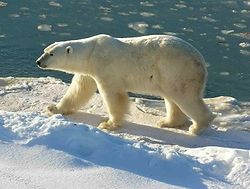 Polar Bear, the National Animal of Greenland |
 Children wearing the National Costume of Greenland |
Iceland
 Coat of arms of Iceland |
 Falcon, the National Animal of Iceland |
 Lady of the mountain, "Fjallkonan" |
Norway
 Elk, the National Animal of Norway |
 National costumes of Norway |
The Sami People
 Sami flag |
 Man wearing traditional Sami costume |
Sámi drum with sun-moon symbol (upper left) |
 Copper carving (1767) by O.H. von Lode showing a Sami noaidi with his drum (meavrresgárri) |
Sweden
 Elk, the National Animal of Sweden |
Mother Svea |
Åland Islands
 Flag of Åland |
 Coat of arms of Åland |
.jpg) Roe Deer, the National Animal of the Åland Islands |
Geography
|
Saana fell in Northern Finland seen from the south. |
 The beach Grenen, Skagen in Denmark |
 Galdhøpiggen in Norway is the highest mountain in Nordic Countries. |
|
 The erupting Great Geysir in Haukadalur valley, Iceland, the oldest known geyser in the world. |
 The southernmost island of the Faroe Islands, Suðuroy. |
 Moskusokselandet in Northeast Greenland National Park, Greenland |
 Archipelago Sea in Finland and Åland is the largest archipelago in the world by the number of islands |
Culture
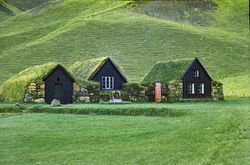 Turf-roofed houses in Iceland. |
 Cemetery at Upernavik, Greenland. Artificial flowers are used for decoration. |
 Traditional wedding in Jomala, Åland |
 A lakeside smoke sauna ("savusauna"/"rökbastu") in Finland |
 Stockholm, the Capital of Sweden, is the largest city in the Nordic countries. |
Urnes stave church in Norway is listed as a World Heritage Site by UNESCO. |
 Faroese folk dancers in national costumes. |
 Gefion Fountain in Copenhagen |
Economy
 Headquarters of Nokia, the largest Finnish company. |
 The Nesjavellir Geothermal Power Plant services the Greater Reykjavík Area's hot water needs. |
A local fisherman in Klaksvík. |
|
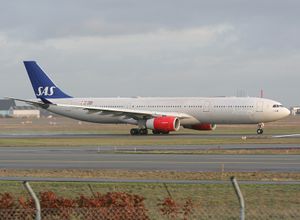 Scandinavian Airlines System is the largest airline in Scandinavia. |
Offshore wind turbines near Copenhagen. |
The Oulu, Finland pulp and paper mill of Stora Enso, a Finnish–Swedish company. |
| Historical populations | ||
|---|---|---|
| Year | Pop. | %± |
| 1800 | 5,161,000 | — |
| 1900 | 12,306,000 | 138.4% |
| 1950 | 18,757,000 | 52.4% |
| 2000 | 24,116,000 | 28.6% |
| 2050? | 31,537,000 | 30.8% |
Population
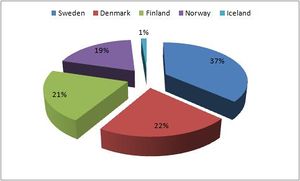
| Name of country, with flag | Population (2009 est.) |
Source | Capital |
|---|---|---|---|
| 27,456 | [4] | Mariehamn | |
| 5,519,287 | [5] | Copenhagen | |
| 49,006 | [6] | Tórshavn | |
| 5,349,829 | [7] | Helsinki | |
| 57,600 | [8] | Nuuk | |
| 319,756 | [9] | Reykjavík | |
| 4,836,183 | [10] | Oslo | |
| 9,336,487 | [11] | Stockholm | |
| Total | 25,382,411 | [12] |
Areas with close relations to the Nordic countries
Several areas have a long and close relationship with and often identify with some or all of the Nordic countries. These are however for the most part not regarded as part of the Nordic group themselves, although classified as Northern Europe by the United Nations.
Shetland and Orkney
The Northern Isles of Scotland—Orkney and Shetland—have a long-established Nordic identity. The islands were Norwegian and Danish colonies for more than 500 years, but ownership defaulted to the crown of Scotland in 1472 following non-payment of the marriage dowry of Margaret of Denmark and Norway, queen of James III of Scotland.
During World War II Shetland and Orkney were important bases for the Norwegian armed forces in exile. The Shetland Bus was based in Shetland and smuggled refugees, agents and supplies to and from Norway.
In later years financial relations, particularly in the maritime industries, have been important. Cultural and sporting exchanges are frequent. A genetic survey showed that 60% of the male population of Shetland and Orkney had Western Norwegian genes.
The traditional links to Scandinavia are reflected in the islands' flags, both of which are based around a Nordic cross:
 |
 |
| Orkney | Shetland |
Other regions of the British Isles have adopted symbols to allude to a similar Norse or Norse-Gaelic heritage.
Scotland
Areas such as Caithness, Sutherland and the Hebrides were under Norse rule for long periods, and the Bishopric of Trondheim formerly controlled large sections of north west Scotland.
The Norn language was spoken in eastern Caithness into medieval times.
Estonia
Estonia is widely considered to be a Baltic state and a part of Northern Europe. Although Estonia is often grouped in Eastern Europe as well, many Estonians themselves consider Estonia to be Nordic rather than Eastern European or Baltic.[13][14] The Estonian language is closely related to the Finnish language, and Estonians, as an ethnic group, are a Finnic people. Sites of the Nordic Bronze Age culture reached as far east as Estonia. Estonia also had close contacts with Scandinavia in the Viking Age. The Oeselians were known in the Old Norse Icelandic Sagas and in Heimskringla as Víkingr frá Esthland (English: Estonian Vikings). With the rise of Christianity, centralized authority in Scandinavia and Germany eventually led to the Northern crusades. The northern part of Estonia was part of medieval Denmark during the 13th-14th centuries, being sold to the Teutonic Order after the St. George's Night Uprising in 1346. The name of the Estonian capital, Tallinn, is thought to be derived from the Estonian taani linn, meaning 'Danish town' (see Flag of Denmark for details). Parts of Estonia were under Danish rule again in the 16th-17th centuries, before being transferred to Sweden in 1645. Estonia was part of the Swedish Empire from 1561 until 1721, when it was ceded to Russia in the Treaty of Nystad, following the outcome in the Great Northern War. The Swedish era became colloquially known in Estonia as the "good old Swedish times". However, the local Baltic German upper classes had stronger political and cultural dominance in the country from the 12th to the early 20th century than the Swedes, Danes, and Russians. There were Finnish, Danish and Swedish volunteer units in the Estonian War of Independence.
 |
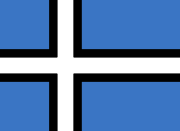 |
 |
| Flag of Estonia | Proposed Estonian flag featuring a Nordic cross |
Flag proposed in 1919 |
Historically, large parts of Estonia’s north-western coast and islands have been populated by an indigenous ethnically Swedish population, the Estonian Swedes. The majority of Estonia's Swedish population fled to Sweden in 1944, escaping the advancing Soviet Army. In 2007, Estonian Swedes were granted official cultural autonomy under Estonian law.[15] Since regaining independence in 1991, Estonia has expressed interest joining the Nordic Council. In 1999, Toomas Hendrik Ilves delivered a speech entitled "Estonia as a Nordic Country" to the Swedish Institute for International Affairs.[16] In 2003, the foreign ministry also hosted an exhibit called "Estonia: Nordic with a Twist."[17] In 2005, Estonia also joined the European Union's Nordic Battle Group. However, Estonia is not considered a Nordic country by the majority of the Nordic populations.
England
Anglo-Saxon England was founded in part by Jutes in Kent, the Isle of Wight and the national saga of England is Beowulf, carried to England by the Wuffings of East Anglia. Much of England, particularly East Anglia, Mercia and Northumbria were once part of the Danelaw. The story of Lady Godiva and Peeping Tom, London Bridge Is Falling Down and Sigurd the Dane of Macbeth fame come from this period of an Anglo-Scandinavian "Empire of the North". After England's population stabilised into a nation-state, Sweyn Forkbeard's family, which went back to Denmark from the Danish colonies in the West (see Harthacnut of Denmark), took over Wessex partly with the excuse of St. Brice's Day massacre and stratified as well as unified the government of England into four regional jarldoms under control by Danes and Norwegians as well as promoting the English church in Scandinavia at the expense of the German church. This led to the later installment of the Archdiocese of Nidaros, which administered the Diocese of Sodor and Man formerly belonging to the Province of York (and would later reconnect upon Norse land cessions) by the English Pope Adrian IV. Direct relations between Denmark and England would continue intermittently until the reign of Eystein II of Norway, but the take overs of both by Eric of Pomerania and William of Normandy respectively, divided their focuses to re-attachment with Continental Europe instead. There was a much later interjection of New Sweden amidst the New England and Virginia colonies, but the relationship was much different in that period.
Northern Germany
Parts of the states in northern Germany, namely Schleswig-Holstein and Hamburg were at times part of Denmark and Lower Saxony, Bremen and Mecklenburg-Vorpommern part of Sweden, and have a long history of cooperation dating back to the medieval Hanseatic League. In the 15th century, Stockholm had a German majority population, and Germans paid more than half of the city's taxes.
Southern Schleswig on the Jutland peninsula was conquered and reconquered both by the Germans and the Danes, i.e. the border between Denmark and Germany changed several times over the centuries. Particularly the northern parts of present Schleswig-Holstein have a significant ethnic Danish minority. The region had a Scandinavian identity in Hedeby and Angeln up until its transfer to Germany in the mid 19th century and its subsequent Germanisation. Today, the Nordic character of Southern Schleswig's society and its inhabitants is still very prominent. There are Danish state schools in the area, and the Danish minority is active both politically and culturally.
Swedish Pomerania was once part of the Swedish kingdom; a time when the local University of Greifswald, at that time Sweden's oldest university, attracted both students and professors from Sweden. The cultural heritage survives in the form of many buildings, though the Swedish population either left the region when the Swedish Empire declined or was assimilated into mainstream German society.
See also
- Scandinavia, Northern Europe, Baltic region
- Baltoscandia
- Subdivisions of the Nordic countries
- Nordic Council, Northern Dimension
- Nordic Cross
- Climate of the Nordic countries
References
- ↑ "Scandinavia" (the term should correctly be used excluding Finland). In Merriam-Webster's Online Dictionary. Retrieved 10 January 2008: "Scandinavia: Denmark, Norway, Sweden—sometimes also considered to include Iceland, the Faeroe Islands, & Finland." (Merriam-Webster Online Dictionary defines "Nordic" as an adjective dated to 1898 with the meaning "of or relating to the Germanic peoples of northern Europe and especially of Scandinavia."), "Scandinavia" (2005). The New Oxford American Dictionary, Second Edition. Ed. Erin McKean. Oxford University Press, ISBN 0-19-517077-6: "a cultural region consisting of the countries of Norway, Sweden, and Denmark and sometimes also of Iceland, Finland, and the Faroe Islands"; Scandinavia (2001). The Columbia Encyclopedia, Sixth Edition. Retrieved January 31, 2007: "Scandinavia, region of N Europe. It consists of the kingdoms of Sweden, Norway, and Denmark; Finland and Iceland are usually considered part of Scandinavia"; Scandinavia. (2007). Encyclopædia Britannica. Retrieved January 31, 2007, from Encyclopædia Britannica Online: "Scandinavia, historically Scandia, part of northern Europe, generally held to consist of the two countries of the Scandinavian Peninsula, Norway and Sweden, with the addition of Denmark"; and Scandinavia. (2006). Microsoft Encarta Online Encyclopedia. Retrieved January 30, 2007: "Scandinavia (ancient Scandia), name applied collectively to three countries of northern Europe—Norway and Sweden (which together form the Scandinavian Peninsula), and Denmark". Archived 2009-11-01.
- ↑ Nordic. Merriam-Webster Online Dictionary. Retrieved 3 March 2008.
- ↑ Saetre, Elvind (2007-10-01). "About Nordic co-operation". Nordic Council of Ministers & Nordic Council. http://www.norden.org/en/about-nordic-co-operation. Retrieved 2008-01-09. "The Nordic countries consist of Denmark, the Faroe Islands, Greenland, Finland, the Åland Islands, Iceland, Norway and Sweden."
- ↑ "ÅSUB". ÅSUB. 2009-03-18. http://www.asub.ax/files/INV09.pdf. Retrieved 2009-01-06.
- ↑ "Quarterly Population (ultimo)". Statistics Denmark. 2009-02-10. http://www.dst.dk/HomeUK/Statistics/Key_indicators/Population/pop_quarterly.aspx. Retrieved 2009-05-08.
- ↑ "Statistics Faroe Islands". Statistics Faroe Islands. 2009-05-06. http://www.hagstova.fo/portal/page/portal/HAGSTOVAN/Statistics_%20Faroe_Islands. Retrieved 2009-05-08.
- ↑ "The current population of Finland". Population Register Center. http://www.vaestorekisterikeskus.fi/vrk/home.nsf/pages/index_eng. Retrieved 2008-10-05.
- ↑ "Greenland". CIA World Factbook. Central Intelligence Agency. 2009-04-23. https://www.cia.gov/library/publications/the-world-factbook/geos/gl.html#People. Retrieved 2009-05-08.
- ↑ "Statistics Iceland". Government. The National Statistical Institute of Iceland. 14 September 2008. http://www.statice.is#Govt. Retrieved 2008-08-14.
- ↑ "Population". Statistics Norway. 2009-05-07. http://www.ssb.no/english/subjects/02/befolkning_en/. Retrieved 2009-05-08.
- ↑ "Befolkningsstatistik". Statistiska centralbyrån. http://www.scb.se/BE0101. Retrieved 2009-05-04.
- ↑ This number was derived by adding up the referenced populations (from the provided table) of Sweden, Denmark, Finland, Norway, Iceland, Greenland, the Faroe Islands, and Åland.
- ↑ "Estonian Life". Estonian Ministry of Foreign Affairs publication, 2004.
- ↑ "Estonian Life". Estonian Ministry of Foreign Affairs publication, 2002.
- ↑ "Estonian Swedes Embrace Autonomy Rights" Citypaper, 2007
- ↑ Ilves, Toomas Hendrik. "Estonia as a Nordic Country". December 14, 1999.
- ↑ "Estonia – Nordic with a Twist". Estonian Ministry of Social Affairs, 2004 (last updated).
External links
- Norden – the Nordic Council and the Nordic Council of Ministers' website.
- Nordregio – a European centre for research, education and documentation on spatial development, established by the Nordic Council of Ministers. Includes maps and graphs.
- Go Scandinavia – official website of the Scandinavian Tourist Boards in North America.
- Scandinavia House – the Nordic Center in New York, run by the American-Scandinavian Foundation.
- vifanord – a digital library that provides scientific information on the Nordic and Baltic countries as well as the Baltic region as a whole.
- Mid Nordic Committee – Nordic organization to promote sustainable development and growth in the region.
|
||||||||
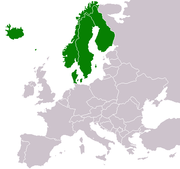

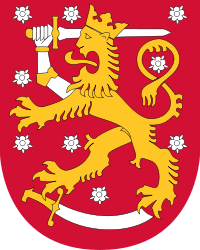



.jpg)
